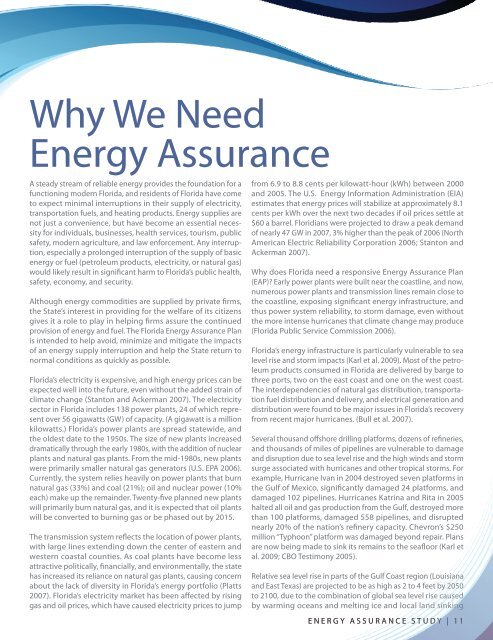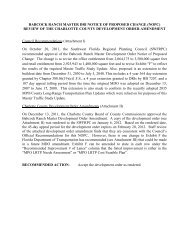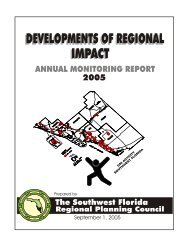Energy Assurance Study: Interim Report - Southwest Florida ...
Energy Assurance Study: Interim Report - Southwest Florida ...
Energy Assurance Study: Interim Report - Southwest Florida ...
- No tags were found...
Create successful ePaper yourself
Turn your PDF publications into a flip-book with our unique Google optimized e-Paper software.
Why We Need<strong>Energy</strong> <strong>Assurance</strong>A steady stream of reliable energy provides the foundation for afunctioning modern <strong>Florida</strong>, and residents of <strong>Florida</strong> have cometo expect minimal interruptions in their supply of electricity,transportation fuels, and heating products. <strong>Energy</strong> supplies arenot just a convenience, but have become an essential necessityfor individuals, businesses, health services, tourism, publicsafety, modern agriculture, and law enforcement. Any interruption,especially a prolonged interruption of the supply of basicenergy or fuel (petroleum products, electricity, or natural gas)would likely result in significant harm to <strong>Florida</strong>’s public health,safety, economy, and security.Although energy commodities are supplied by private firms,the State’s interest in providing for the welfare of its citizensgives it a role to play in helping firms assure the continuedprovision of energy and fuel. The <strong>Florida</strong> <strong>Energy</strong> <strong>Assurance</strong> Planis intended to help avoid, minimize and mitigate the impactsof an energy supply interruption and help the State return tonormal conditions as quickly as possible.<strong>Florida</strong>’s electricity is expensive, and high energy prices can beexpected well into the future, even without the added strain ofclimate change (Stanton and Ackerman 2007). The electricitysector in <strong>Florida</strong> includes 138 power plants, 24 of which representover 56 gigawatts (GW) of capacity. (A gigawatt is a millionkilowatts.) <strong>Florida</strong>’s power plants are spread statewide, andthe oldest date to the 1950s. The size of new plants increaseddramatically through the early 1980s, with the addition of nuclearplants and natural gas plants. From the mid-1980s, new plantswere primarily smaller natural gas generators (U.S. EPA 2006).Currently, the system relies heavily on power plants that burnnatural gas (33%) and coal (21%); oil and nuclear power (10%each) make up the remainder. Twenty-five planned new plantswill primarily burn natural gas, and it is expected that oil plantswill be converted to burning gas or be phased out by 2015.The transmission system reflects the location of power plants,with large lines extending down the center of eastern andwestern coastal counties. As coal plants have become lessattractive politically, financially, and environmentally, the statehas increased its reliance on natural gas plants, causing concernabout the lack of diversity in <strong>Florida</strong>’s energy portfolio (Platts2007). <strong>Florida</strong>’s electricity market has been affected by risinggas and oil prices, which have caused electricity prices to jumpfrom 6.9 to 8.8 cents per kilowatt-hour (kWh) between 2000and 2005. The U.S. <strong>Energy</strong> Information Administration (EIA)estimates that energy prices will stabilize at approximately 8.1cents per kWh over the next two decades if oil prices settle at$60 a barrel. Floridians were projected to draw a peak demandof nearly 47 GW in 2007, 3% higher than the peak of 2006 (NorthAmerican Electric Reliability Corporation 2006; Stanton andAckerman 2007).Why does <strong>Florida</strong> need a responsive <strong>Energy</strong> <strong>Assurance</strong> Plan(EAP)? Early power plants were built near the coastline, and now,numerous power plants and transmission lines remain close tothe coastline, exposing significant energy infrastructure, andthus power system reliability, to storm damage, even withoutthe more intense hurricanes that climate change may produce(<strong>Florida</strong> Public Service Commission 2006).<strong>Florida</strong>’s energy infrastructure is particularly vulnerable to sealevel rise and storm impacts (Karl et al. 2009). Most of the petroleumproducts consumed in <strong>Florida</strong> are delivered by barge tothree ports, two on the east coast and one on the west coast.The interdependencies of natural gas distribution, transportationfuel distribution and delivery, and electrical generation anddistribution were found to be major issues in <strong>Florida</strong>’s recoveryfrom recent major hurricanes. (Bull et al. 2007).Several thousand offshore drilling platforms, dozens of refineries,and thousands of miles of pipelines are vulnerable to damageand disruption due to sea level rise and the high winds and stormsurge associated with hurricanes and other tropical storms. Forexample, Hurricane Ivan in 2004 destroyed seven platforms inthe Gulf of Mexico, significantly damaged 24 platforms, anddamaged 102 pipelines. Hurricanes Katrina and Rita in 2005halted all oil and gas production from the Gulf, destroyed morethan 100 platforms, damaged 558 pipelines, and disruptednearly 20% of the nation’s refinery capacity. Chevron’s $250million “Typhoon” platform was damaged beyond repair. Plansare now being made to sink its remains to the seafloor (Karl etal. 2009; CBO Testimony 2005).Relative sea level rise in parts of the Gulf Coast region (Louisianaand East Texas) are projected to be as high as 2 to 4 feet by 2050to 2100, due to the combination of global sea level rise causedby warming oceans and melting ice and local land sinkingENERGY ASSURANCE STUDY | 11









